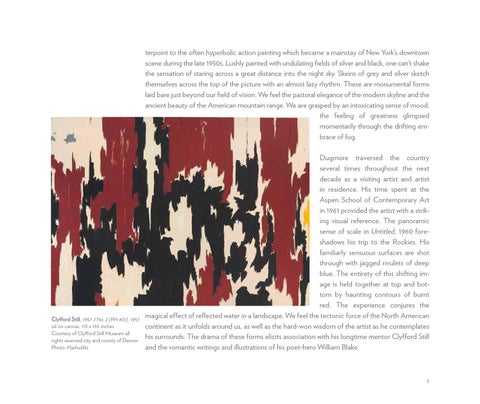terpoint to the often hyperbolic action painting which became a mainstay of New York’s downtown scene during the late 1950s. Lushly painted with undulating fields of silver and black, one can’t shake the sensation of staring across a great distance into the night sky. Skeins of grey and silver sketch themselves across the top of the picture with an almost lazy rhythm. These are monumental forms laid bare just beyond our field of vision. We feel the pastoral elegance of the modern skyline and the ancient beauty of the American mountain range. We are grasped by an intoxicating sense of mood, the feeling of greatness glimpsed momentarily through the drifting embrace of fog.
Clyfford Still, 1957 J No. 2 (PH 401), 1957 oil on canvas, 113 x 155 inches Courtesy of Clyfford Still Museum all rights reserved city and county of Denver Photo: Harholdts
Dugmore traversed the country several times throughout the next decade as a visiting artist and artist in residence. His time spent at the Aspen School of Contemporary Art in 1961 provided the artist with a striking visual reference. The panoramic sense of scale in Untitled, 1960 foreshadows his trip to the Rockies. His familiarly sensuous surfaces are shot through with jagged rivulets of deep blue. The entirety of this shifting image is held together at top and bottom by haunting contours of burnt red. The experience conjures the magical effect of reflected water in a landscape. We feel the tectonic force of the North American continent as it unfolds around us, as well as the hard-won wisdom of the artist as he contemplates his surrounds. The drama of these forms elicits association with his longtime mentor Clyfford Still and the romantic writings and illustrations of his poet-hero William Blake.
5
